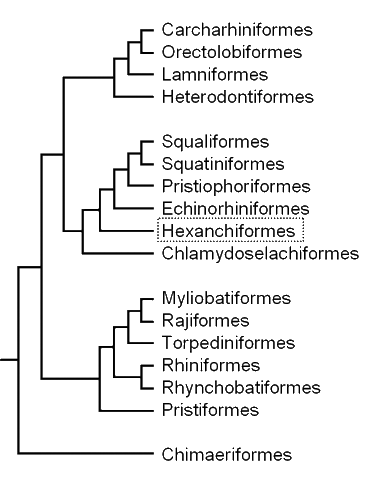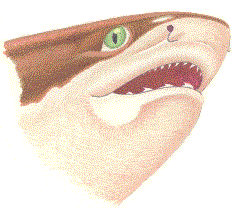Order Hexanchiformes:
Cow Sharks — 4 species

- ‘extra’ pairs of gill slits — the group’s scientific name means “six arches”, referring to the gills, but may have either six (in Hexanchus) or seven (in Heptranchias and Notorynchus) pairs
- presence of an anal fin
- a single dorsal fin, located far back on the body
- ovoviviparous (retaining thin-shelled eggs within the mother’s body, later to be born alive)
- exclusively marine, most inhabiting deep outer continental shelf and slope waters; found in cold waters from boreal through temperate and tropical zones of the Atlantic, Pacific, and Indian Oceans
- 3 genera in 3 families

|

|
|
|
|
|
A representative hexanchoid, the Bluntnose Sixgill Shark (Hexanchus griseus) displays the 'extra' pair of gill slits, single dorsal fin, and cockscomb-shaped lower teeth characteristic of cowsharks. Note the denticle-free 'bald patch' at the base of the pectoral fin and the odd 'bump' in the lateral line at the base of the caudal fin. |
|
The hexanchiform sharks are mysterious creatures that lead secret lives, often in the deepest, darkest, coldest parts of the ocean. Due to the inaccessible depths inhabited by these sharks, we know very little about them.
The hexanchoids - collectively termed 'cow sharks' - are of stout build, having underslung jaws armed with thorn-like teeth above and unique, cockscomb-shaped teeth below. The Bluntnose Sixgill shark (Hexanchus griseus) is the largest hexanchoid, growing to more than 15.5 feet (4.8 metres) in length, while the Sharpnose Sevengill shark (Heptranchias perlo) is the smallest, growing to a maximum length of 4.5 feet (1.4 metres). The Bluntnose Sixgill shark has the largest litters of any hexanchoid, ranging from 22 to 108 pups, each about 28 inches (70 centimetres) long. This species typically inhabits depths greater than 300 feet (90 metres), and has been recorded as deep as 6,150 feet (1,875 metres). Like many deep-sea creatures, the Bluntnose Sixgill is known to undertake nightly vertical migrations (travelling surfaceward at night, returning to the depths before dawn).
Each July to November at certain locations off the coast of British Columbia, Canada, discrete populations of Bluntnose Sixgills enter depths accessible by scuba (often less than 80 feet or 24 metres) - much to the delight of local divers and underwater photographers. My ongoing studies suggest that these normally deep-sea sharks enter local shallow waters to take advantage of the rich feeding here, where their prey included Lingcod, Cabezon, Spiny Dogfish (Squalus ancanthias), and Pacific hagfish. The Sixgills' arrival in shallow water coincides with the local salmon and herring runs and may benifit from the cover of autumnal plankton blooms, which greatly reduce the intensity of underwater light (the eyes of Bluntnose Sixgills are permanently dark-adapted, and individuals seem greatly distressed by even moderate ambient light levels). This population of Sixgills apparently also gives birth while in shallow waters, as evidenced by neonates (newborns, identifiable by a vitelline scar on the chest between the pectoral fins) caught in areas just shoreward of the these haunted by the sub-adults and adults. In these sheltered bays, there is plenty for the young sharks to feed upon but few predators large enough to endanger them in turn. In winter when local plankton populations dwindle and the waters clear, the Sixgills disappear - perhaps to deeper waters below 300 feet (90 metres). Wherever the Bluntnose Sixgills go, they are not seen again until the next autumn. A tagging and observation program has revealed the many of the same individual Sixgills return year after year. In response, a significant dive tourism industry has developed around these shallow-water Sixgills, generating some 5 to 10 million dollars annually.
 Unlike most hexanchoids, the Broadnose Sevengill Shark (Notorynchus
cepedianus) is primarily an inhabitant of shallow coastal waters and adapts
readily to living in public aquaria.
As a result, this species' basic life history and behavior are better known
than those of any other hexanchoid. Although it is found world-wide in
temperate seas, the Broadnose Sevengill has been most studied in Californian and
South African waters, thanks primarily to efforts by ichthyologist David
Ebert. In California waters, this species apparently coordinates its
movements with the tidal cycle, moving into shallow bays with the rising tide
and out with its fall. these movements are important to both its breeding
and feeding biology. After a gestation period of about 12 months, up to
82, 20-inch (50-centimetre) pups are born in spring and summer, using shallow
bays (such as San Francisco Bay) as nursery areas. The pups grow rapidly,
males becoming mature at a length of about 5 feet (1.5 metres) and females at
about 8 feet (2.5 metres).
Unlike most hexanchoids, the Broadnose Sevengill Shark (Notorynchus
cepedianus) is primarily an inhabitant of shallow coastal waters and adapts
readily to living in public aquaria.
As a result, this species' basic life history and behavior are better known
than those of any other hexanchoid. Although it is found world-wide in
temperate seas, the Broadnose Sevengill has been most studied in Californian and
South African waters, thanks primarily to efforts by ichthyologist David
Ebert. In California waters, this species apparently coordinates its
movements with the tidal cycle, moving into shallow bays with the rising tide
and out with its fall. these movements are important to both its breeding
and feeding biology. After a gestation period of about 12 months, up to
82, 20-inch (50-centimetre) pups are born in spring and summer, using shallow
bays (such as San Francisco Bay) as nursery areas. The pups grow rapidly,
males becoming mature at a length of about 5 feet (1.5 metres) and females at
about 8 feet (2.5 metres).
Growing to a maximum length of about 10 feet (3 metres) and sporting a handsome peppering of dark spots, the Broadnose Sevengill is a potent predator and scavenger in coastal bays, skulking a wide range of depths from the intertidal down to at least 165 feet (50 metres), eating practically everything that is not bolted down. Known food includes gastropods, octopuses, crabs, lampreys, sharks and rays (Brown Smoothhounds [Mustelus henlei] and Bat Rays [Myliobatis californicus] are major prey items in California waters), a wide range of teleost fishes (such as salmon, sturgeon, and anchovies), seals, carrion, and even rats that had somehow ended up in the ocean. Off southern Africa, this species feeds on squids, crustaceans, a wide range of elasmobranch and teleost fish prey, fur seals, and even dolphins, employing at least separate predatory strategies. The Broadnose Sevengill is also known to feed cooperatively on pinnipeds in both Californian and South African waters.

Broadnose Sevengill Shark (Notorynchus
cepedianus)
In captivity, this species has bitten divers and in the wild it has behaved aggressively toward divers and spearfishermen. It may also be responsible for shallow water attacks on swimmers and bathers in temperate coastal waters. Human remains have been found in the stomach of one specimen, but it is unknown whether this grisly meal was obtained through predation or scavenging.
The Sharpnose and Broadnose Sevengills are usually classified with the other cow sharks in the family Hexanchidae, but some workers have recently argued that they are sufficiently distinct to be placed in their own families, Heptranchiidae and Notorynchidae respectively. This classification is followed here.

